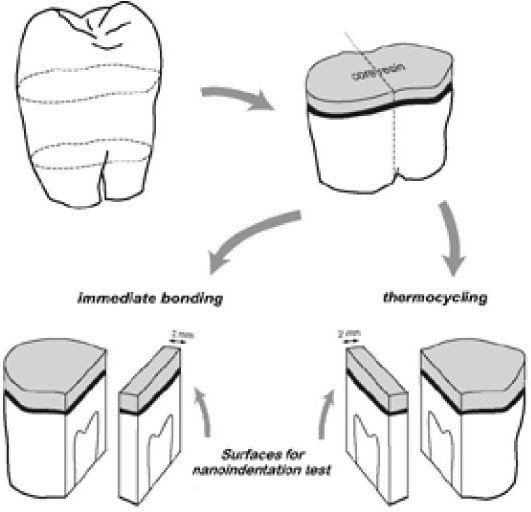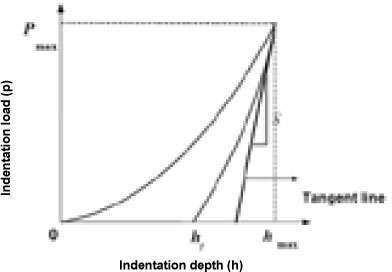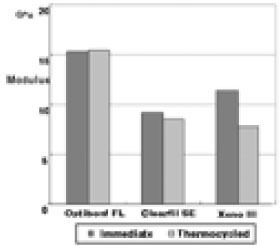J Korean Acad Conserv Dent.
2008 Jan;33(1):45-53. 10.5395/JKACD.2008.33.1.045.
Comparison of the elastic modulus among three dentin adhesives before and after thermocycling
- Affiliations
-
- 1Department of Conservative Dentistry and Dental Research Institute, School of Dentistry, Seoul National University, Seoul, South Korea. hhson@snu.ac.kr
- 2Craniomaxillofacial Life Science 21 and Dental Research Institute, School of Dentistry, Seoul National University, Seoul, South Korea.
- KMID: 1986749
- DOI: http://doi.org/10.5395/JKACD.2008.33.1.045
Abstract
- The purpose of this study was to determine the effects on the elastic moduli of the adhesive and the hybrid layer from thermocycling. Twenty one human molars were used to create flat dentin surfaces. Each specimen was bonded with a light-cured composite using one of three commercial adhesives (OptiBond FL [OP], Clearfil SE Bond [CL], and Xeno III [XE]). These were sectioned into two halves and subsequently cut to yield 2-mm thickness specimens; one specimen for immediate bonding test without thermocycling and the other subjected to 10,000 times of thermocycling. Nanoindentation test was performed to measure the modulus of elasticity of the adhesive and the hybrid layer, respectively, using an atomic force microscope. After thermocycling, XE showed a significant decrease of the modulus in the adhesive layer (p < 0.05). Adhesives containing hydrophilic monomers are prone to hydrolytic degradation. It may result in the reduced modulus of elasticity, which leads to the mechanically weakened bonding interface.
Keyword
MeSH Terms
Figure
Reference
-
1. Hashimoto M, Ohno H, Sano H, Kaga M, Oguchi H. In vitro degradation of resin-dentin bonds analyzed by microtensile bond test, scanning and transmission electron microscopy. Biomaterials. 2003. 24:3795–3803.
Article2. Breschi L, Mazzoni A, Ruggeri A, Cadenaro M, Di Lenarda R, De Stefano Dorigo. Aging and stability of the bonded interface. Dent Mater. 2007. 16:16. (in press).3. Dijken JW, Sunnegardh-Gronberg K, Lindberg A. Clinical long-term retention of etch-and-rinse and self-etch adhesive systems in non-carious cervical lesions A 13 years evaluation. Dent Mater. 2007. 23:1101–1107.
Article4. Ito S, Hashimoto M, Wadgaonkar B, Svizero N, Carvalho RM, Yiu C, et al. Effects of resin hydrophilicity on water sorption and changes in modulus of elasticity. Biomaterials. 2005. 26:6449–6459.
Article5. De Munck J, Van Meerbeek B, Yoshida Y, Inoue S, Vargas M, Suzuki K, et al. Four-year water degradation of total-etch adhesives bonded to dentin. J Dent Res. 2003. 82:136–140.
Article6. Carrilho MR, Tay FR, Pashley DH, Tjaderhane L, Carvalho RM. Mechanical stability of resin-dentin bond components. Dent Mater. 2005. 21:232–241.
Article7. Angker L, Nockolds C, Swain MV, Kilpatrick N. Correlating the mechanical properties to the mineral content of carious dentine--a comparative study using an ultra-micro indentation system (UMIS) and SEM-BSE signals. Arch Oral Biol. 2004. 49:369–378.
Article8. Marshall GW Jr, Balooch M, Gallagher RR, Gansky SA, Marshall SJ. Mechanical properties of the dentinoenamel junction: AFM studies of nanohardness, elastic modulus, and fracture. J Biomed Mater Res. 2001. 54:87–95.
Article9. Oliveira SS, Marshall SJ, Habelitz S, Gansky SA, Wilson RS, Marshall GW Jr. The effect of a self-etching primer on the continuous demineralization of dentin. Eur J Oral Sci. 2004. 112:376–383.
Article10. Inoue G, Tsuchiya S, Nikaido T, Foxton RM, Tagami J. Morphological and mechanical characterization of the acid-base resistant zone at the adhesive-dentin interface of intact and caries-affected dentin. Oper Dent. 2006. 31:466–472.
Article11. Oliver WC, Pharr GM. An improved technique for determining hardness and elastic modulus using load and displacemen sensing indentaion experimens. J Mater Res. 1992. 7:1564–1583.
Article12. Ge J, Cui FZ, Wang XM, Feng HL. Property variations in the prism and the organic sheath within enamel by nanoindentation. Biomaterials. 2005. 26:3333–3339.
Article13. Doerner MF, Nix WD. A method for interpreting the data from depth-sensing indentation instruments. J Mater Res. 1986. 1:601–609.
Article14. Donmez N, Belli S, Pashley DH, Tay FR. Ultrastructural correlates of in vivo/in vitro bond degradation in self-etch adhesives. J Dent Res. 2005. 84:355–359.
Article15. Reis AF, Giannini M, Pereira PN. Long-term TEM analysis of the nanoleakage patterns in resin-dentin interfaces produced by different bonding strategies. Dent Mater. 2007. 23(9):1164–1172.
Article16. Yuan Y, Shimada Y, Ichinose S, Tagami J. Qualitative analysis of adhesive interface nanoleakage using FE-SEM/EDS. Dent Mater. 2007. 23(5):561–569.
Article17. Toledano M, Osorio R, Albaladejo A, Aguilera FS, Osorio E. Differential effect of in vitro degradation on resin-dentin bonds produced by self-etch versus total-etch adhesives. J Biomed Mater Res A. 2006. 77:128–135.18. Koshiro K, Inoue S, Tanaka T, Koase K, Fujita M, Hashimoto M, et al. In vivo degradation of resin-dentin bonds produced by a self-etch vs. a total-etch adhesive system. Eur J Oral Sci. 2004. 112:368–375.
Article19. Tay FR, Suh BI, Pashley DH, Prati C, Chuang SF, Li F. Factors contributing to the incompatibility between simplified-step adhesives and self-cured or dual-cured composites. Part II. Single-bottle, total-etch adhesive. J Adhes Dent. 2003. 5:91–105.20. Hashimoto M, Ohno H, Sano H, Tay FR, Kaga M, Kudou Y, et al. Micromorphological changes in resin-dentin bonds after 1 year of water storage. J Biomed Mater Res. 2002. 63:306–311.
Article21. Burrow MF, Inokoshi S, Tagami J. Water sorption of several bonding resins. Am J Dent. 1999. 12:295–298.22. Reis AF, Giannini M, Pereira PN. Influence of water-storage time on the sorption and solubility behavior of current adhesives and primer/adhesive mixtures. Oper Dent. 2007. 32:53–59.
Article23. Malacarne J, Carvalho RM, de Goes MF, Svizero N, Pashley DH, Tay FR, et al. Water sorption/solubility of dental adhesive resins. Dent Mater. 2006. 22:973–980.
Article24. Hosaka K, Tagami J, Nishitani Y, Yoshiyama M, Carrilho M, Tay FR, et al. Effect of wet vs. dry testing on the mechanical properties of hydrophilic self-etching primer polymers. Eur J Oral Sci. 2007. 115:239–245.
Article25. Van Meerbeek B, Willems G, Celis JP, Roos JR, Braem M, Lambrechts P, et al. Assessment by nano-indentation of the hardness and elasticity of the resin-dentin bonding area. J Dent Res. 1993. 72:1434–1442.
Article26. Hosoya Y, Tay FR. Hardness, elasticity, and ultrastructure of bonded sound and caries-affected primary tooth dentin. J Biomed Mater Res B Appl Biomater. 2007. 81:135–141.
Article27. Drummond JL. Nanoindentation of dental composites. J Biomed Mater Res B Appl Biomater. 2006. 78:27–34.
Article28. Xu HH, Smith DT, Jahanmir S, Romberg E, Kelly JR, Thompson VP, et al. Indentation damage and mechanical properties of human enamel and dentin. J Dent Res. 1998. 77:472–480.
Article29. Senawongse P, Harnirattisai C, Otsuki M, Tagami J. Effect of LED light-curing time for the adhesive resin on the modulus of elasticity. Am J Dent. 2007. 20:139–141.30. Reis AF, Giannini M, Pereira PN. Effects of a peripheral enamel bond on the long-term effectiveness of dentin bonding agents exposed to water in vitro. J Biomed Mater Res B Appl Biomater. 2007. 6:6. (in press).31. Toledano M, Osorio R, Osorio E, Aguilera FS, Yamauti M, Pashley DH, et al. effects of direct/indirect exposure and storage media. Dent Mater. 2007. 23:885–892.32. Gale MS, Darvell BW. Thermal cycling procedures for laboratory testing of dental restorations. J Dent. 1999. 27:89–99.
Article
- Full Text Links
- Actions
-
Cited
- CITED
-
- Close
- Share
- Similar articles
-
- THE TENSLE BOND STRENGTH AND ELASTIC MODULUS OF THE SOFT DENTURE LINING MATERIALS
- THE STUDY ON THE PHYSICAL PROPERTY OF THE PERMANENT SOFT DENTURE LINERS
- The effects of dentin bonding agent thickness on stress distribution of composite-tooth interface : Finite element method
- A comparative study of shear bond strength of flowable resin associated with dentin adhesive systems with thermocycling effect
- Relationship between laboratory bond strengths and clinical performance of dentin adhesives





